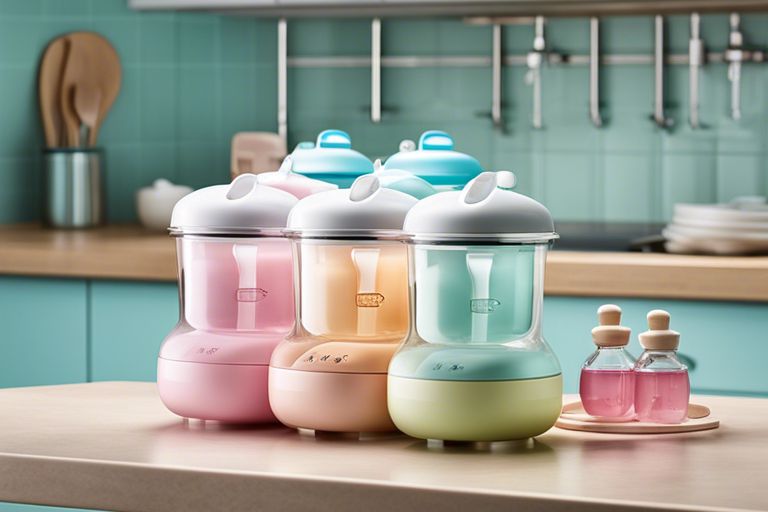tips, tricks and guides for parenthood
Just welcomed a new addition to the family? Congratulations! As a new parent, ensuring your little one's feeding equipment is properly sterilized is crucial for their health and well-being. In this guide, we'll walk you through the important steps on how to sterilize baby bottles effectively to protect your baby from harmful bacteria and germs. Let's dive in and learn the best practices for sterilizing baby bottles to keep your bundle of joy safe and healthy.

Some necessary items you'll need to prepare for sterilizing baby bottles include a sterilizer, bottles, teats, bottle brush, drying rack, tongs, and water.
What should you consider before starting the sterilization process? It's important to make sure that all the equipment is cleaned thoroughly before sterilizing. Ensure there are no milk residues left in the bottles as this can lead to bacterial growth. The sterilizer should be in good working condition and checked regularly. The water level in the sterilizer needs to be appropriate for effective sterilization. The bottles should be completely submerged in water.
Even though the boiling method is a traditional approach, it is still an effective way to sterilize your baby's bottles. Simply immerse all parts of the bottle in a pot of boiling water for at least 5 minutes. Remember to ensure that there are no air bubbles trapped in the bottles or teats. It is best to use tongs to handle the items to avoid burns.
While boiling is effective, some parents prefer chemical sterilization methods for convenience. You can use sterilizing solutions or tablets that are specifically designed for baby bottles. These solutions are easy to use and can effectively kill germs and bacteria. Ensure you follow the manufacturer's instructions for the correct dilution and soaking time.
Techniques: Chemical sterilization is quick, convenient, and can be done without the need for boiling water. However, it is important to handle these chemicals with care and store them out of reach of children. Always ensure thorough rinsing of bottles after chemical sterilization to remove any residue that may be harmful to your baby.
Despite the excitement of welcoming a new baby, sterilizing baby bottles is an necessary task for new parents to ensure their little one's health and safety. Here are some key factors to consider:
As far as sterilizing baby bottles, there are various methods to choose from, including boiling, steam sterilizing, using sterilizing solution, or microwave sterilizing. It is advisable to follow the manufacturers' instructions on how to clean the bottles effectively to maintain hygiene levels. Thou, for more information on How do i sterilize baby bottles & is it actually important?.
Many new parents wonder how to maintain the sterility of their baby bottles once they have been sterilised. Proper storage is key to ensuring that your bottles remain germ-free until they are ready to be used. Be sure to store your sterile bottles in a clean, dry place with a lid or cap on to prevent any contamination. Perceiving any signs of dirt or dust, always re-sterilise the bottles before use.
To ensure the sterility of your baby bottles is maintained, it's crucial to handle them correctly after sterilisation. After sterilising your bottles, always remember to wash your hands thoroughly before handling them. Use clean tongs or utensils to remove them from the steriliser and avoid touching the inside of the bottles. Allow them to air dry in a clean area before sealing them for storage.
On the whole, sterilising baby bottles is a crucial step in maintaining your little one's good health. By following the steps outlined in this guide, new parents can ensure that their baby's feeding equipment is clean and safe for use. Whether you choose to sterilise by boiling, using a sterilising solution, or an electric steam steriliser, the key is consistency and thoroughness. Remember to keep all equipment sterile until the moment you are ready to use it and store it properly to maintain its cleanliness. With these practices in place, you can have peace of mind knowing that you are taking the necessary steps to protect your baby from harmful germs and bacteria. Happy feeding!
A: Sterilizing baby bottles helps prevent harmful bacteria from contaminating your baby's milk or formula, reducing the risk of infections.
A: It is recommended to sterilize baby bottles before the first use and then at least once a day, especially for younger babies.
A: The most common methods for sterilizing baby bottles are using a sterilizer, boiling them in water, or using a microwave steam sterilizer.
A: Yes, many dishwashers have a sterilization cycle that can effectively sterilize baby bottles along with other feeding equipment.
A: If the bottles are left in a sterilizer with a closed lid, they can remain sterile for around 24 hours. Once you open the sterilizer, it is best to use the bottles immediately.